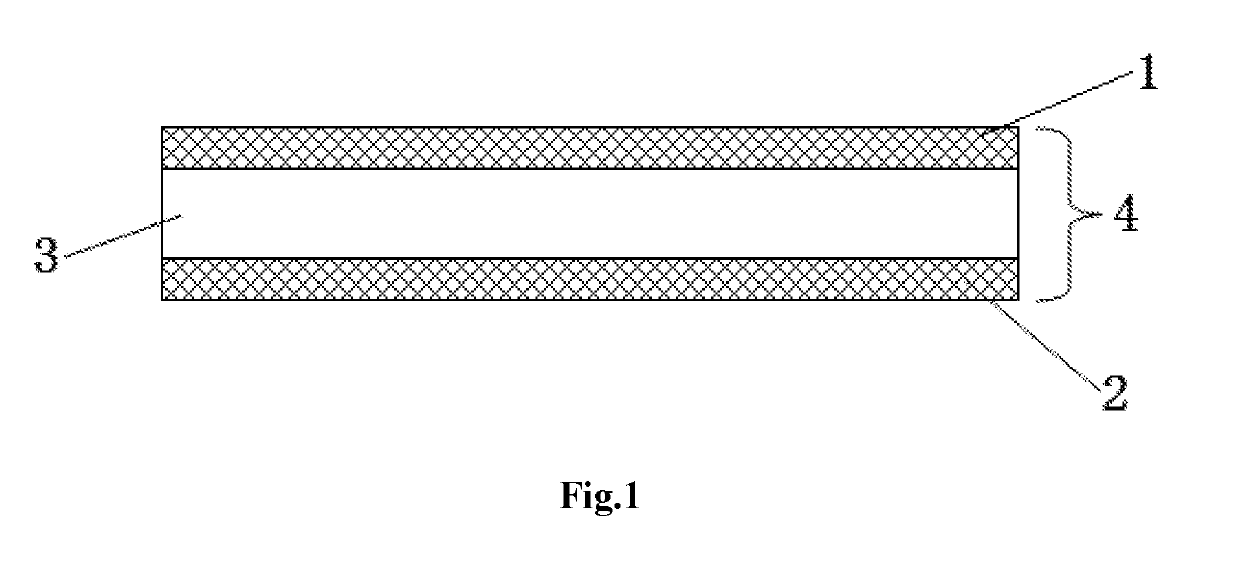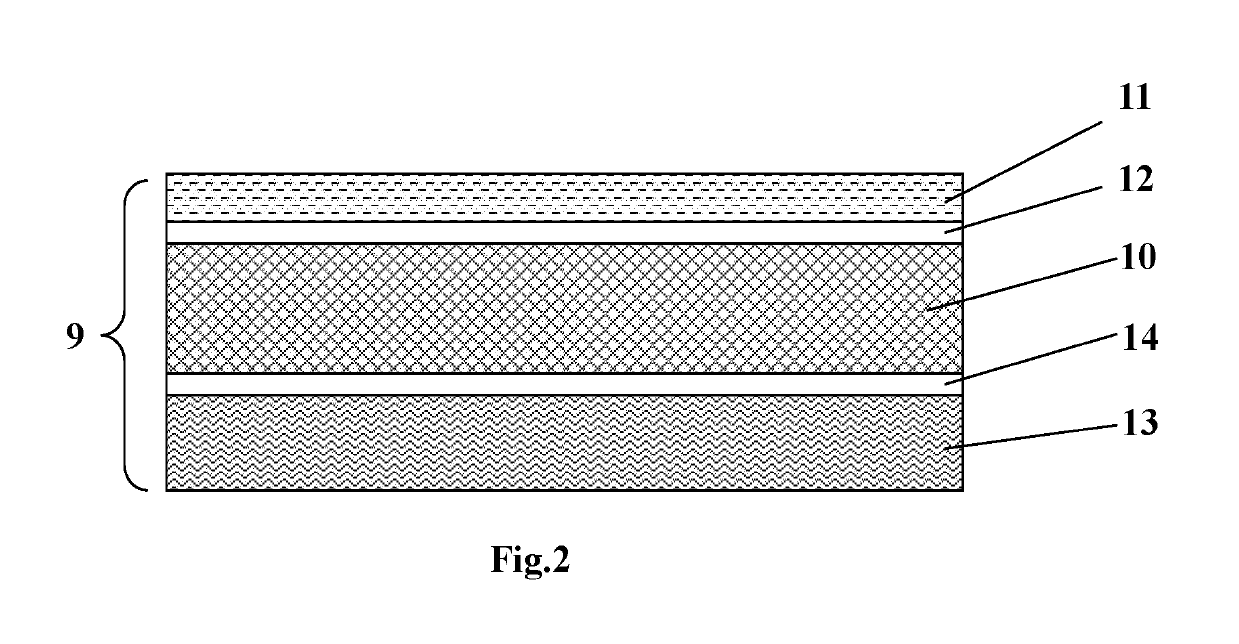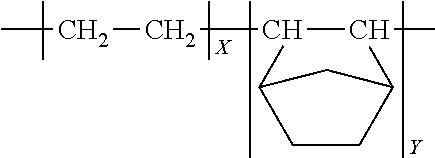Co-extruded one-time-formed solar cell module backboard in three-layer structure
a solar cell module and backboard technology, applied in the field of one-time-formed solar cell module backboard in a three-layer structure, can solve the problems of poor heat conduction efficiency and heat resistance, low rate, and affect the power generation efficiency of the cell, and achieve high water resistance radio, good long-term ageing resistance, and high reflective rate
- Summary
- Abstract
- Description
- Claims
- Application Information
AI Technical Summary
Benefits of technology
Problems solved by technology
Method used
Image
Examples
embodiment 1
[0031]FIG. 1 is a structural schematic diagram of a solar cell module backboard 4 in a three-layer structure. The solar cell module backboard 4 comprises a middle layer 3 which is located in the middle as well as an outer layer 1 and an outer layer 2 which are located at the two sides of the middle layer; and is made by three-layer co-extrusion one-time continuous production, namely, hybrid polymer films are formed by a high-temperature co-extrusion film making process,
[0032]wherein the outer layer 1 comprises raw materials (by mass percent, similarly hereinafter) of 88% of PA12 and 12% of TiO2 and is 0.050 mm in thickness;
[0033]the chemical formula of the outer layer 1 is: [NH—(CH2)11—CO]n; the inner layer 2 comprises raw materials of 19% of EVA, 69% of LLDPE and 12% of TiO2 and is 0.050 mm in thickness;
[0034]the chemical formula of the inner layer 2 is: (C2H4)x(C4H6O2)+(C2H4)n,
[0035]wherein the chemical formula of EVA is: (C2H4)x(C4H6O2)y, and the chemical formula of LLDPE is: (C2...
embodiment 2
[0039]FIG. 1 is a structural schematic diagram of a solar cell module backboard 4 in a three-layer structure. The solar cell module backboard 4 comprises a middle layer 3 which is located in the middle as well as an outer layer 1 and an outer layer 2 which are located at the two sides of the middle layer,
[0040]wherein the outer layer 1 comprises raw materials of 88% of PA12 and 12% of TiO2 and is 0.050 mm in thickness;
[0041]the chemical formula of PA12 is: [NH—(CH2)11—CO]n;
[0042]the inner layer 2 comprises raw materials of 88% of PA12 and 12% of TiO2 and is 0.050 mm in thickness:
[0043]the middle layer 3 comprises raw materials of 98% of PA12 and 2% of TiO2 and is 0.250 mm in thickness;
[0044]Hybrid polymer films are formed by a high-temperature co-extrusion film making process.
embodiment 3
[0045]FIG. 1 is a structural schematic diagram of a solar cell module backboard 4 in a three-layer structure. The solar cell module backboard 4 comprises a middle layer 3 which is located in the middle as well as an outer layer 1 and an outer layer 2 which are located at the two sides of the middle layer, and is made by three-layer co-extrusion one-time continuous production,
[0046]wherein the outer layer 1 comprises raw materials of 65% of HDPE-g-GMA, 23% of PA12 and 12% of TiO2 and is 0.050 mm in thickness, and the chemical formula of HDPE is:
[—CH2—CH2—]n;
[0047]the inner layer 2 comprises raw materials of 65% of HDPE-g-GMA, 23% of PA12 and 12% of TiO2 and is 0.050 mm in thickness; and
[0048]the middle layer 3 composes raw materials of 58% of HOPE 20% of PP-g-GMA, 20% of PA12 and 2% of TiO2 and is 0.250 mm in thickness. A crosslinking reaction is carried out on a part of raw materials by a high-temperature co-extrusion film making process, so as to form hybrid polymer alloy films.
[00...
PUM
| Property | Measurement | Unit |
|---|---|---|
| thickness | aaaaa | aaaaa |
| thickness | aaaaa | aaaaa |
| weight ratio | aaaaa | aaaaa |
Abstract
Description
Claims
Application Information
 Login to View More
Login to View More - R&D
- Intellectual Property
- Life Sciences
- Materials
- Tech Scout
- Unparalleled Data Quality
- Higher Quality Content
- 60% Fewer Hallucinations
Browse by: Latest US Patents, China's latest patents, Technical Efficacy Thesaurus, Application Domain, Technology Topic, Popular Technical Reports.
© 2025 PatSnap. All rights reserved.Legal|Privacy policy|Modern Slavery Act Transparency Statement|Sitemap|About US| Contact US: help@patsnap.com



